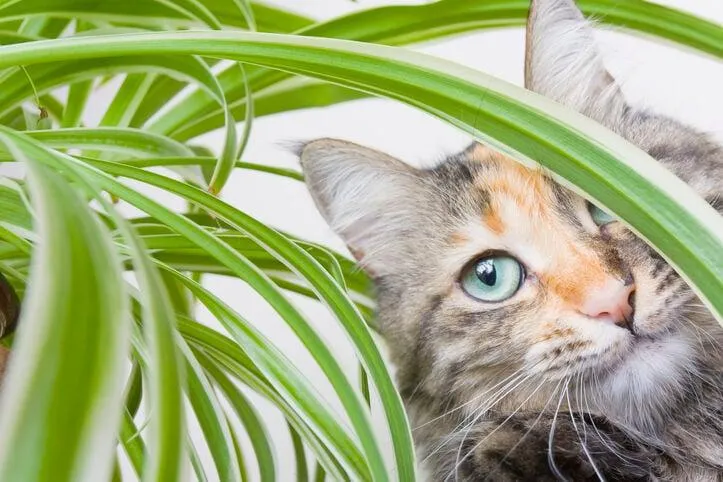Is the Pachira aquatica Plant Poisonous to Cats?
As a cat owner and plant lover, I’ve faced situations where my curious kitty would nibble on unfamiliar plants in our home. So it’s important for pet parents like us to be well informed about which common houseplants may pose a risk. In this article, I’ll provide a comprehensive overview of the Pachira aquatica and examine if it can harm cats.
Overview of Pachira aquatica
Commonly known as the money tree or Malabar chestnut, Pachira aquatica is a popular indoor foliage plant that originates from Central and South America. It grows well in average indoor conditions and has become a staple of many contemporary homes. With its odd shape combining a thick trunk and large palm-like leaves, it provides an interesting aesthetic element. While it can survive in regular potting soil, the “aquatica” part of its scientific name hints that it thrives when its roots are submerged in water or kept constantly moist.
Toxic Principles in Pachira aquatica
Botanists have identified various toxins present in different parts of the Pachira aquatica plant. The seeds contain cytotoxic triglycerides that can cause vomiting and diarrhea if ingested in large quantities. The foliage contains calcium oxalate crystals which are irritants that may result in mild oral irritation or upset stomach for cats. While not usually life-threatening, it’s best to keep cats from accessing any part of the money tree.

Signs of Poisoning in Cats
If a curious cat were to chew on the leaves or nibble the bark of a Pachira aquatica plant, some signs of mild toxicity may emerge within 30 minutes to 2 hours and include:
- Drooling
- Vomiting
- Diarrhea
- Excess salivation
- Mouth irritation
- Loss of appetite
In severe cases where a large amount was ingested, signs may involve lethargy, dilated pupils, increased heart rate, or respiratory issues. It’s important to monitor cats closely for 24 hours if they are suspected of eating parts of the money tree and seek veterinary care right away if concerning symptoms develop.
Overall Verdict and Safety Tips
While the Pachira aquatica is unlikely to cause more than minor, temporary upset when nibbled by cats, it’s best to consider it moderately poisonous due to the potential for irritation. To keep both plants and pets healthy in the home, I recommend:

- Keeping money trees and other potentially toxic plants well out of reach by placing them high or behind closed doors.
- Testing the soil of pots for any fertilizers or chemicals that could sicken cats if ingested during normal grooming.
- Supervising interactions when cats and houseplants share the same space.
- Knowing the phone number for a pet poison control hotline to call if an exposure occurs.
With some basic precautions, it’s possible to enjoy indoor gardens and furry friends side by side safely. I hope this guide has helped answer your questions about the toxicity risks posed by Pachira aquatica for feline companions. Please let me know if you need any other plant or pet advice!
Is Pachira aquatica poisonous to cats?
| Fact | Details |
|---|---|
| Toxic parts | All parts of the Pachira aquatica plant are toxic to cats, including leaves, stems, seeds, and flowers. |
| Toxic compounds | The plant contains compounds called saponins and cyanogenic glycosides that can cause vomiting and diarrhea in cats. |
| Symptoms of poisoning | Vomiting, diarrhea, weakness, difficulty breathing. More severe poisoning could cause seizures or death. |
| Risk of ingestion | Cats may accidentally ingest parts of the plant by chewing on or ingesting leaves, stems, seeds or flowers they find on the ground or on houseplants. |
| Treatment | Veterinary treatment is necessary. Induce vomiting if the cat ingested the plant within the past 1-2 hours. Fluids and supportive care may be needed. |
FAQ
-
Is Pachira aquatica poisonous to cats?
Basically, Pachira aquatica, also known as the Malabar chestnut or Chinese money plant, contains compounds that can make cats sick if eaten. The milky sap and plant parts contain toxins that can cause vomiting and diarrhea in cats if they chew on or ingest pieces of the plant. So it’s probably best to keep this plant out of reach of curious kitties.
-
What are the signs that a cat has eaten Pachira aquatica?
If Fluffy gets into your money plant, watch out for signs like drooling, vomiting, lack of appetite, diarrhea, or lethargy. These can indicate your little furball accidentally nibbled on a toxic part of the plant. The good news is that with proper veterinary treatment for poisoning symptoms, most cats recover just fine after a day or two. Just don’t wait too long to get them checked out.

-
How dangerous is it really?
At the same time, many other plant substances are mildly toxic when large amounts are consumed. Surprisingly, the risk from a small amount of money plant appears relatively low, as long as your cat doesn’t make a total meal out of it. Nevertheless, it’s smarter to play it safe and keep your furry friends away from houseplants completely whenever practical. Better they chow down on catnip toys than greenery, right?
-
What should I do if my cat eats part of a money plant?
If you happen to catch Fluffy in the act of nibbling plant leaves, remove the money plant from their reach immediately. Then, contact your vet or the ASPCA Animal Poison Control Center hotline. Drink lots of water and watch for symptoms over the next 24 hours. At the first sign of trouble, take kitty straight to the vet. There’s no point in stressing if only a tiny bite was taken. Chances are, no news is good news in this case. But call your vet if you’re worried.
-
Can human eat Pachira aquatica?
Actually, many parts of the money plant are edible for humans! Did you know the seeds can be roasted and ground into a flour? They’re reported to have a pleasant nutty taste. Some people even chew the raw seeds for breath freshening. Sounds cliché, but I’d still run potential edibles by a doctor before nibbling, just to be safe. I’d hate for anyone’s cat-like curiosity to land them in the emergency room. Stick to store-bought snacks if you ask me!

-
Does the plant pose any other risks besides being poisonous?
On the other hand, improperly cared for money plants can develop molds or bacterial diseases just like any houseplant. So good hygiene practices are key. While quite sturdy, its brittle branches and sharp thorns technically pose a minor puncture or tear hazard too if roughly handled. Overall though, as long as kept out of pet and child reach, this tropical plant adds lush beauty to any home without too much real risk. Just be mindful like with any greenery indoors.
-
Are there any non-toxic alternatives to Pachira aquatica as a houseplant?
Two kind of similar looking options that are definitely pet-safe include the Chinese evergreen (Aglaonema modestum) and dieffenbachia or dumb cane (Dieffenbachia spp.). With their colorful leaves and tolerance of low-light conditions, these make great替money plant substitutes without any potential toxicity concerns for clumsy kitties. So if furry friends are part of the household, you might consider switching to one of those stunningly pretty plants instead.
